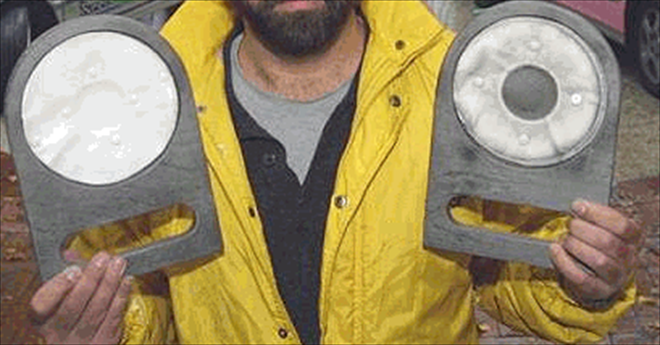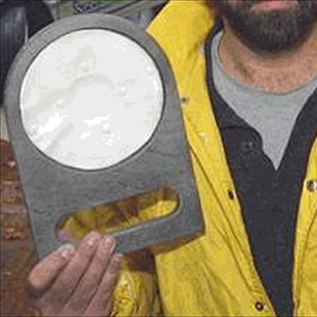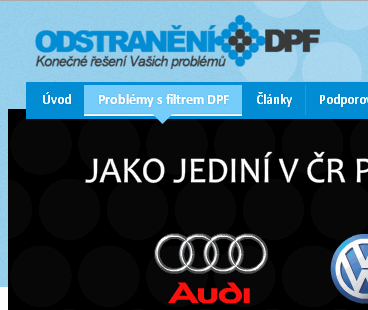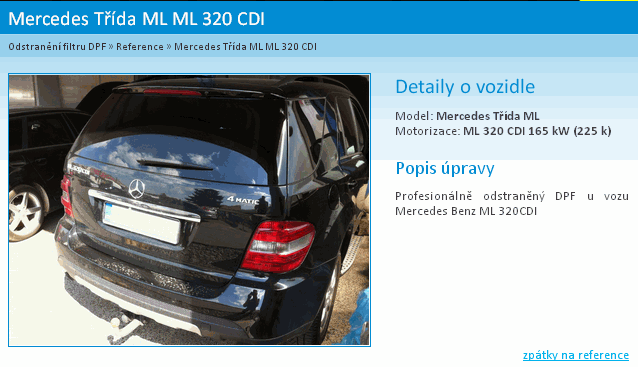


Environmentalists that clean DPF filters and at the same time are removing them are quoting on their web pages one time an option to clean and the second time the opposite, to remove. These quotes will satisfy everyone. Non-functional and low quality DPF filters are offered for sale for a low price. Chemical cleaning agents and fuel additives regularly used in fuel tanks are promissing to solve your DPF filter problems permanently.
The same provider on the same street address is quoting once: "Some people are having their DPF filters removed on purpose, and in fact they do not realize that they are cutting off the branch they are sitting on." Their other web: "Do you want to permanently solve your DPF problems? Place an order to have it removed!" Now make a decision!
An employee of a company that removes filters said in a TV spot that "Emission testing stations cannot detect a removed DPF filter, there is no way how they can tell this".
This is one big mistake!!! Our training center for emission test center technicians is teaching how to detect removed DPF filters. So far, we have not come across such a sophisticated removal method where we haven't been able to detect a removed filter. There is one clear fact, during vehicle emission testing a removed DPF filter will be always detected. Correctly working DPF filter will have a maximum absorption coefficient value of 0,03 m-1. When the vehicle doesn't have a DPF filter this value will be 10x higher. If all the customers of such companies were to stand in line and file claims that they were deceived and cheated these companies would go bankrupt while restoring vehicles to their original homologated state.

The internet web activities have several problems:
 Emission test technicians in some countries are LIABLE FOR THEIR ACTIONS WITH THEIR PERSONAL PROPERTY. This is not the case in all countries. Also, the training of emission test technician is not sufficient and, in particular, the topic of DPF filters has many issues. It is not that complicated as it looks, and there are several methods and procedures that can detect a removed DPF filter with 100% reliability. These methods and procedures go as far as that they can even reveal a cracked filter. So to summarize this, it is not a problem to detect and prove with certainty that the DPF filter has been either removed illegally or that the filters efficiency is low due to cracks in the filter caused by unqualified cleaning or various cleaning substances (chemicals, steam cleaners, high pressure water cleaners).
Emission test technicians in some countries are LIABLE FOR THEIR ACTIONS WITH THEIR PERSONAL PROPERTY. This is not the case in all countries. Also, the training of emission test technician is not sufficient and, in particular, the topic of DPF filters has many issues. It is not that complicated as it looks, and there are several methods and procedures that can detect a removed DPF filter with 100% reliability. These methods and procedures go as far as that they can even reveal a cracked filter. So to summarize this, it is not a problem to detect and prove with certainty that the DPF filter has been either removed illegally or that the filters efficiency is low due to cracks in the filter caused by unqualified cleaning or various cleaning substances (chemicals, steam cleaners, high pressure water cleaners).
What is the truth?
In reality, some of the vehicles don't require filter cleaning or replacement. The condition is that nonburnable particles are not causing filter saturation or that the filter is not cracked. If the vehicle is OK it has the capability to burn the flammable soot always by itself. It only requires high exhaust temperature around 700°C. This temperature is achievable only if the oxidation catalytic converter is fully functional. When diesel fuel is applied to the converter, the converter begins an oxidation process of the unburnt hydrocarbons and increase its temperature to 200-300°C or higher. No soot can survive this temperature inside the filter and behind it. Only nonburnable ash will remain.
What about chemical solutions promising "clean filters"?
Chemical solutions work differently to what their manufacturers claim. These so called "miracle cleaners" should only be used to unblock a completely soot saturated filter so that the saturation is reduced to a level that will allow regeneration. After this, it is necessary to ensure that the regeneration was successful and that the engine and engine management system is OK. The main problem with the chemical solutions is that many of the users are too quick, and they start driving the vehicle when the filter is still wet. Most of these customers are happy after this operation, but quite a few have damaged the filters efficiency. If the vehicle is driven with a wet filter it will very frequently crack due to water evaporation. Soot will flow through these cracks and will not stay in the filter. We can tell this from a black coloured exhaust tailpipe (soot) and from the higher smoke emissions that are increase 5-10x (absorption about k = 0,3 - 0,7m-1) compared to the homologation value (about k = 0,01 m-1). Another problem could be manipulated vehicle odometer values on used vehicles. The customer is surprised that he has problems with the DPF filter, increased fuel consumption or even increased engine oil levels due to oil dilution with fuel. In the majority of cases this is caused by the oxidation catalytic converter that has been driven for so many kilometers that it has lost its efficiency and is not capable of generating sufficient temperature to start the regeneration process.
What about cheap DPF filters?
The truth is that their price doesn't differ too much compared to the returned used converter. Another fact is that these super cheap filters with integrated converters usually contain the same amount of platinum as the old converters being scrapped. This is their main problem. Such cheap converters with very limited amounts of platinum will work for a short time only or they may not even work at all. The regeneration temperature on these converters will drop and the process will not start. So we are back with the same problem.
What is the situation with filter cleaning?
It is possible to verify easily if the filter after cleaning is working correctly or not. During first service regeneration, the temperature behind the oxidation converter must rise some 200°C higher than the temperature in front of the converter. The exhaust system (tailpipe) during normal vehicle operation shouldn't any signs of soot. The exhaust resistance should not have a higher value than about 0 - 7 hPa (mbar) at idle. If this is not the case, then the DPF filter still contains a large amount of residue material that wasn't removed from the filter. The cleaning provider doesn't take over the guarantee for the functionality of the oxidation layer. It is highly recommended that the function of the oxidation converter is verified before the filter is sent for cleaning. The condition is that it is possible to perform such a verification.
What do we understand by the term if someone claims "professionally removed DPF filter"? I am sure that you have come across this many times. The vehicle is running in LIMP IN HOME mode, and no DTC is logged in memory. This is what some call professional intervention. When the professional modification of the ECU causes deactivation of DTCs, after which it is impossible to find the values required to repair a vehicle that shouldn't be allowed on the road.

Komentáře (0)
Vložit soubor